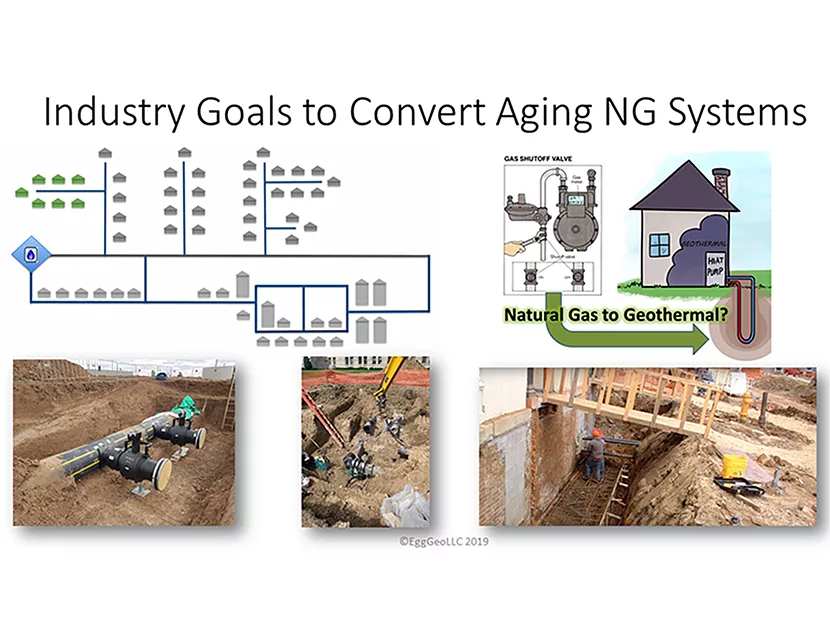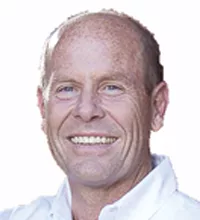The heating and cooling industry is changing in some remarkable ways. We’ve all heard about district heating and cooling systems, which are more common on foreign soil (as with Stockholm and Norway), or limited downtown districts. But imagine this:
A natural gas distribution company has put an application in to its Department of Public Utilities to install three central geothermal systems, or GeoMicroDistricts (Figure 2). These central pipelines carry ambient or ground temperature water to buildings, which will be equipped with geothermal heat pumps (GHPs).

It happened in Massachusetts. The natural gas energy company, Eversource, has applied to do districts for multifamily buildings, dense urban or mixed-use, and purely residential. The system will use ground-source heat pump technology, which uses electricity to transfer heat from the ambient temperature GeoMicroDistrict (in the ground) to a network of geothermal heat pumps to provide clean heating and cooling for the buildings within each district.
This model will shortly spread into New York, throughout the Northeast (including Ontario, Canada) and quickly throughout North America. It means double-digit billions of dollars in work for the trades, and it ensures decades, even generations of infrastructure build-out.
When I started in the GHP industry in 1990, I was asked by a reporter what the future held for the industry. I said that while excavation and drilling are required now for the systems, the day would come when geothermal pipelines would be worked into the infrastructure of communities (Figure 3). It’s now a reality, three decades later.

Why did it take more than 30 years to get to this level (public utilities)? Why now? Here’s the rest of the story.
Global warming potential of natural gas
We have an aging natural gas infrastructure. The news has been filled with stories of the billions of dollars needed to replace these aging pipelines in cities all over the country. At the same time, carbon or greenhouse gas emissions have come under fire, as well as the fear of combustion fuel-related dangers in homes and businesses.
In Massachusetts, Eversource determined that it needed to replace 25 percent of the state’s aging, leaky natural gas infrastructure at a cost of about $9 billion over the next 20 years. It’s only the beginning of the challenges.
A “Building Energy Magazine” article reports that unburned natural gas, or methane, is a more potent greenhouse gas than we could have imagined; it has 84 times the impact of CO2, an impact lasting 20 years, notes the International Panel on Climate Change. Concerning global warming and climate change, natural gas is considered a top priority for elimination. (For more information, see the article links at the end of this column.)
With the effort to curb natural gas use, new NG pipelines would become a stranded asset that would never pay off because the NG would be basically outlawed long before the end of its useful life. But new laws passed in Massachusetts, New York and many other state and local jurisdictions are changing that.
The hurdles remaining include:
• Allowing gas companies to bill for BTUs.
• Creation of a “renewable thermal credit” market.
• A path to 100 percent renewable thermal by 2050.
• Limitation of gas infrastructure depreciation beyond 2050.
• Permitting the creation of renewable thermal infrastructure — ambient geothermal pipelines in place of the natural gas systems (Figure 4).

To accomplish this, the Gas Leaks Allies, including HEET (the Home Energy Efficient Team), worked together with Massachusetts legislators to create the For a Utility Transition to Using Renewable Energy legislation, or the FUTURE bill (H.2849/S.1940), hoping for passage in 2020.
This is a great transition for pipefitters in the NG industry. Both natural gas and ambient geothermal districts use polyethylene pipe. But several trades will benefit. The U.S. Department of Energy notes in its GEOVision report that geothermal technologies will be responsible for a tremendous increase in trades employment, far more than solar or wind (Figure 5).

The trade sectors include plumbing, sheet metal and ductwork, electrical, hydrogeology, well drilling, geotechnical, excavation, welding, structural, HVAC and building controls, as well many different professions from plant managers and engineers to architects.
The GeoMicroDistrict
In looking toward these clean technologies, there was concern that air-source heat pumps don’t work everywhere, and would place a tremendous burden on the electric grid — much higher than ground-source heat pumps. More importantly, not all consumers have access and this model alone would require the collapse of the gas industry.
What they were looking for was something safe, renewable, resilient and reliable at a low cost for consumers while allowing gas utility workers to keep their jobs with minimal legislative and regulatory change. It also would need to be scalable and flexible. (GeoMicroGrids have piped infrastructure, similar to a water main.)
The plan is to replace Massachusetts’ aging NG gas infrastructure with new GeoMicroDistricts. Boston’s NG system is 43 percent leak-prone. The map in Figure 6 shows only the leaks targeted for the next five years. Repairs and upgrades (for all Massachusetts) are likely to cost $9 billion in the next 17 years. With a 40-year amortization, these would become “stranded assets.”

HEET released an RFP in late fall 2018, and in a webinar presented the first image as a GeoMicroDistrict, which would evolve into this grid pattern of branches (Figure 7). BuroHappold was awarded the project and produced The GeoMicroDistrict report, which concluded that the system “re-purposes the existing public utility structure, financing, workforce and customer base to deliver safe, clean and affordable heating and cooling.”

The GeoMicroDistrict system would be installed and operated using the existing right-of-way. It would consist of vertical boreholes and an ambient water loop connecting to the ground-source heat pumps in a customer’s building.
The transition from fossil fuels to clean geothermal grids benefits all parties in the following ways:
• Provides long-term thermal capacity.
• Cuts summer electric grid peaks.
• Adapts to changing climate.
• Provides resilience (stormproof and weatherproof).
• Is nonflammable (water-based).
• Provides equitable access to renewable energy.
Much like the effort that was moving forward in 2017 with the natural gas utility Enbridge in Ontario, the path forward in Massachusetts has been proven financially feasible and practical. The geothermal model provides a way forward for gas and electric utilities to work in harmony as GeoMicroDistricts replace the gas infrastructure, and new heating needs are met with new ambient geothermal networks.
To learn more about geothermal technologies and receive CEUs at the same time, check out Introduction to Geothermal Systems Technology at http://bit.ly/2OSQdJC.
Note: The terminology GeoMicroDistrict, ambient geothermal networks, pipelines or distribution as applied to geothermal systems are used interchangeably. These all have the common thread of an ambient or an earth temperature fluid pipeline used as a utility to provide energy exchange for geothermal heat pump systems in homes and buildings.
For further information:
• Department of Energy GEOVision report, https://bit.ly/2NsRHw9
• Building Energy Magazine, “A Utility-Scale Path from Gas to Renewable Thermal,’ https://bit.ly/2Mhr64y
• Renewable Energy World, “Can Natural Gas Giants Switch to Geothermal?” https://bit.ly/2MgYI2v
• HEET, www.heetma.org
• Renewable Energy World, “How Canada is Converting to Geothermal, and How the US Will, Too,” https://bit.ly/2MgKPBx
• Renewable Energy World, “The Tale of Two Sisters — Natural Gas and Electricity in New York and Ontario,” https://bit.ly/34JtxU1
• GreenBiz, “Why natural gas makes global warming worse,” https://bit.ly/2Z8xUqo
Special thanks to Zeyneb Magavi for much of the information shared in this column. She led HEET’s Large Volume Leak Study, which developed a method to rapidly cut emissions from leaking pipe in half. She has worked at BBNTechnologies, Harvard University and in multiple start-ups. Her healthy home renovation in 2008 was in a USGBC Greenbuild tour on PBS NOW. She is committed to creating and driving forward just and wise solutions to the urgent challenge of climate change through multidisciplinary problem solving, co-creation and innovation.





